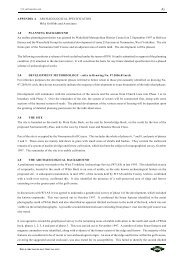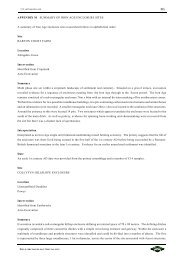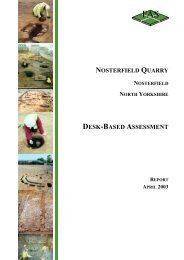ARCHAEOLOGICAL EVALUATION - Mike Griffiths and Associates
ARCHAEOLOGICAL EVALUATION - Mike Griffiths and Associates
ARCHAEOLOGICAL EVALUATION - Mike Griffiths and Associates
You also want an ePaper? Increase the reach of your titles
YUMPU automatically turns print PDFs into web optimized ePapers that Google loves.
FAS_lbf01.wpd 175<br />
have been identified. This may reflect a deeper water table at Ladybridge Farm, but the presence of surface peat<br />
deposits in the lower-lying areas strongly suggests that waterlogged gypsum hollows are present at Ladybridge<br />
Farm. One c<strong>and</strong>idate has been identified at the north end of the Ladybridge Farm site where h<strong>and</strong> augering by<br />
FAS identified a small area of deep organic sediments (auger records 144-146). Here, a shallow surface<br />
depression, roughly 50 m across <strong>and</strong> up to 0.8 m deep contains up to 2.5m of stratified organic <strong>and</strong> organomineral<br />
sediments. It is possible that this represents a relatively large infilled gypsum hollow.<br />
Larger sediment-filled depressions at Ladybridge Farm<br />
Two shallow sediment-filled depressions have been identified at Ladybridge Farm but, as noted above, the<br />
process responsible for their formation is not certain. While it is reasonable to propose that these hollows<br />
originated by gypsum subsidence, it is also possible that they represent kettle holes. These are closed<br />
depressions in the surface of the fluvio-glacial sediments, formed by the melting of masses of ice within the<br />
sediments. It is not possible to confirm which of these processes (gypsum dissolution or ice melt) is responsible<br />
for the depressions at Ladybridge Farm.<br />
The first depression is located to the west of Ladybridge Farm <strong>and</strong> forms a southern continuation of the large<br />
wet area of l<strong>and</strong> known as The Flasks. This wetl<strong>and</strong> formerly extended further south again but this area has<br />
already been quarried. The Flasks has already been investigated as part of the programme of archaeological<br />
works for Nosterfield Quarry <strong>and</strong> the preliminary data from Ladybridge Farm conform to these earlier results.<br />
The portion of The Flasks within the Ladybridge Farm site measures roughly 140 x 170 m <strong>and</strong> lies 1 m below<br />
the drier l<strong>and</strong> immediately to the east. A preliminary auger survey by FAS has proved up to 1.5m of sediments.<br />
The upper layers are peats (up to 0.9m thick) overlying marl <strong>and</strong> fine-textured mineral sediments.<br />
The second of the two depressions is a shallow closed basin on the east side of the site. The depression, which<br />
is enclosed by a fence, measures roughly 200 x 100 m <strong>and</strong> is 1-2m lower that the surrounding l<strong>and</strong>. It is also<br />
distinctly wetter than the surrounding fields <strong>and</strong> a preliminary auger survey by FAS has recorded in excess of<br />
1.5 m of sediment fill in the centre of the depression. The upper part of this fill is peat.<br />
10.1.4 Assessment of Significance of the palaeoenvironmental resource<br />
Palaeoenvironmental potential of gypsum subsidence features<br />
Gypsum subsidence creates closed hollows <strong>and</strong> depressions on the l<strong>and</strong> surface, allowing sediments to<br />
accumulate as the features are filled in. As these sediments accumulate, they have the potential to incorporate<br />
<strong>and</strong> preserve a proxy record of the local environment in the form of micro-fossils (e.g. pollen or phytoliths),<br />
plant <strong>and</strong> animal macro-fossils, or in the properties of the actual sediments. The potential value of these records<br />
will be determined by a number of factors:<br />
<br />
<br />
<br />
<br />
Preservation of the evidence after burial<br />
Rate of sediment accumulation<br />
Stratigraphic integrity of the record<br />
Ability to date the record<br />
A high value palaeoenvironmental record will be one where a range of material types have survived burial,<br />
FIELD ARCHAEOLOGY SPECIALISTS







